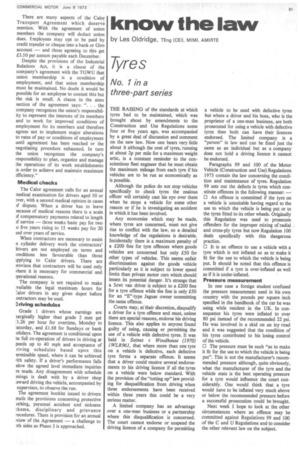know the law
Page 83

If you've noticed an error in this article please click here to report it so we can fix it.
by Les Oldridge, TEng (CEI), MIMI, AMIRTE
Tyre s
No. 1 in a three-part series
THE RAISING of the standards at which tyres had to be maintained, which was brought about by amendments to the Construction and Use Regulations some four or five years ago, was accompanied by a great deal of discussion and comment on the new law. Now one hears very little about it although the cost of tyres, running at about 2p per mile for a maximum weight artic, is a constant reminder to the con scientious fleet engineer that he must obtain the maximum mileage from each tyre if his vehicles are to be run as economically as is possible.
Although the police do not stop vehicles specifically to check tyres the zealous officer will certainly cast his eye over them when he stops a vehicle for some other reason or if he is investigating an accident in which it has been involved.
Any economies which may be made, where tyres are concerned, must not give rise to conflict with the law, so a detailed knowledge of the regulations is desirable. Incidentally there is a maximum penalty of a £200 fine for tyre offences where goods vehicles are concerned but only £50 for other types of vehicles. This seems unfair discrimination against the goods vehicle particularly as it is subject to lower speed limits than private motor cars which should lessen its potential danger. It's strange that a 5cwt van driver is subject to a £200 fine for a tyre offence while the fine is only £50 for an "E"-type Jaguar owner committing the same offence.
Courts may, at' their discretion, disqualify a driver for a tyre offence and must, unless there are special reasons, endorse his driving licence. This also applies to anyone found guilty of using, causing or permitting the use of a vehicle with defective tyres. It was
held in Saines v Woodhouse (1970) 1WL,R961, that where more than one tyre
on a vehicle is defective, each defective tyre forms a separate offence. It seems that a driver could receive several endorse ments to his driving licence if all the tyres on a vehicle were below standard. With the provision of the "totting up" law provid ing for disqualification from driving when three endorsements have been received within three years this could be a very serious matter.
A limited company has an advantage over a one-man business or a partnership where this disqualification is concerned. The court cannot endorse or suspend the driving licence of a company for permitting a vehicle to be used with defective tyres but where a driver and his boss, who is the proprietor of a one-man business, are both prosecuted for using a vehicle with defective tyres then both can have their licences endorsed. The limited company is a "person" in law and can be fined just the same as an individual but as a company does not hold a driving licence it cannot be endorsed.
Paragraphs 99 and 100 of the Motor Vehicle (Construction and Use) Regulations 1973 contain the law concerning the condi tion and maintenance of tyres. Regulation 99 sets out the defects in tyres which con. stitute offences in the following manner: — El An offence is committed if the tyre on a vehicle is unsuitable having regard to the use to which the vehicle is being put or to the tyres fitted to its other wheels. Originally this Regulation was used to prosecute offenders for the improper mixing of radial and cross-ply tyres but now Regulation 100 deals specifically with this dangerous practice.
0 It is an offence to use a vehicle with a tyre which is not inflated so as to make it fit for the use to which the vehicle is being put. It should be noted that this offence is committed if a tyre is over-inflated as well as if it is under-inflated.
Pressure measurement In one case a foreign student confused the pressure measurement used in his own country with the pounds per square inch specified in the handbook of the car he was using while resident in the UK. In con sequence his tyres were inflated to over 80 psi instead of the recommended 22 psi. He was involved in a skid on an icy road and it was suggested that the condition of his tyres contributed to his losing control of the vehicle.
0 The pressure must be such "as to make it fit for the use to which the vehicle is being put". This is not the manufacturer's recom mended pressure although, quite obviously, what the manufacturer of the tyre and the vehicle state is the best operating pressure for a tyre would influence the court considerably. One would think that a tyre
would have to be inflated very much above
or below the recommended pressure before a successful prosecution could be brought. Next week I hope to look at the other circumstances where an offence may be committed against Regulations 99 and 100 of the C and U Regulations and to consider the other relevant law on the subject.












































































































































